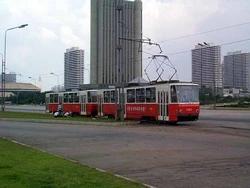Trams in Pyongyang is a communication system tramway in the capital of North Korea - Pyongyang.
Communication tram has a key role, because the people of North Korea can not have private cars. Tramways support those parts of the city, which does not reach metro and trolley buses.
History[]
The beginnings of communications the tram in Pyongyang back to the time of Japanese occupation. Since 1910, followed by the strong expansion of the city, where the May 23, 1923, he left the first electric streetcar, replacing the previously used horse-drawn tram. Tram lines have suffered greatly in the 50s Twentieth century, during the Korean War, and then they have already been rebuilt and communication tram eliminated.
Formal launch of the first new tram line (Songsin - Man'gyŏngdae) took place April 15, 1991 - the 79th birthday of Kim Il Sung, and 3 days later, the line available to travelers. In 1992 he started a second line (T'osŏng - Rangrang - Munsu), while the third opening (Sŏp'yŏngyang - Rangrang) took place in 1995. The first two lines are 1435 mm gauge, while the third is a narrow-gauge line (1,000 mm) intended mainly for tourists and joins an underground station Samhung the mausoleum of Kim Il Sung. Tramway has three depots. Trams in the capital of North Korea, however, are very slow. Since the beginning of the regeneration is not carried out any repairs, and the old rolling stock is also suitable for exchange.
Types of trams[]
Since the beginning of the operation used exclusively Czechoslovakian Tatra cars T6B5K, KT8D5K and KT4K. During the operation closed down joints in the two-part trucks KT4.
In the period 1996-1998 also bought about 100 pieces of used cars Tatra T4D with doczepami b4d previously operated in East Germany (Dresden, Magdeburg, Leipzig).
On the line are used Swiss narrow gauge wagons previously worked at Zurich (18 units of motor vehicles and 18 doczep).
